A number of comparisons have been made with classical analytical results and tests. Some of these relate to ambient temperature behaviour, and although is intended primarily for use in modelling the structural response to high temperatures, it can also be used at a constant temperature but under increasing load to analyse conventional conditions for which classical solutions are available. The comparisons described below cover the following cases:
Plastic analysis of an asymmetric beam at ambient temperature
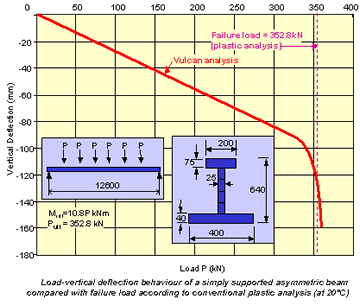
Vulcan has been used to analyse the load-deflection behaviour of an asymmetric beam at ambient temperature. Details of the beam and the analytical results are shown in the figure, compared with the moment capacity of the section based on a simple plastic analysis. These indicate that, as the load is increased, the deflection increases, gradually in the first instance but increasingly rapidly as the moment capacity is approached. The point at which deflections might be regarded as running away compares very closely with the idealised plastic moment capacity, indicating that models collapse behaviour well.
Large deflection analysis of a cantilever beam at ambient temperature
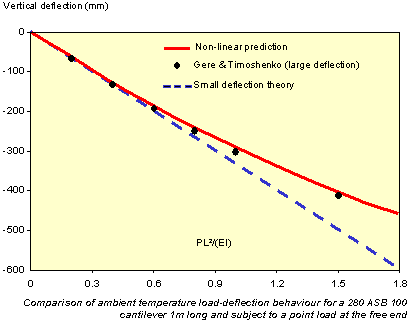
This classical example of an elastic cantilever loaded at its free end was used to check the representation of geometrical non-linearity. Fig. 2 shows the effect of increasing the applied load (P) up to a maximum deflection of almost half of the span. The comparisons with theoretical solutions for this example [1] are very good, and it is clear that, for large deflections, the inclusion of geometrical non-linearity is very important.
Ambient temperature tests on simply supported composite beams with partial interaction
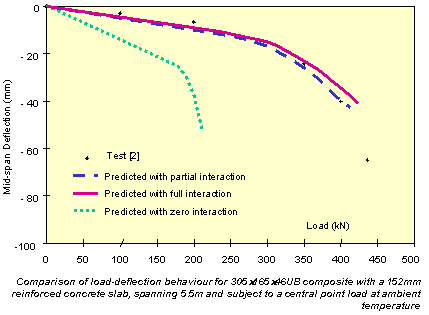
The results of ambient temperature tests on two simply supported composite beams [2] with partial interaction are compared with analytical results in this figure. It is evident that the analytical predictions are in good agreement with test results. The degree of composite action is clearly very important for the beams – the maximum load capacity with no interaction is less than half of that for full-interaction.
Simply supported composite beams tested using ISO834 standard fire
The results of two ISO834 standard fire tests on simply supported composite beams [3] are compared with analytical results in these figures.
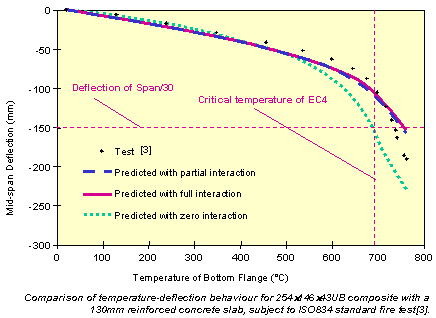
They show reasonable agreement, particularly in view of the uncertainties associated with fire testing. For example, there is little data concerning temperature variation along the length of the beam, simple support conditions are very difficult to produce in a furnace at high temperatures and high deflections, and some assumptions have been made concerning material properties.
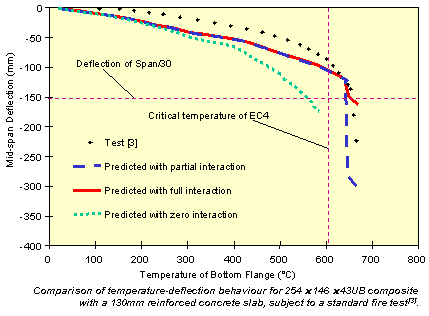
The nominal ambient temperature values of material properties reported were: compressive strength of concrete 30N/mm2; yield strength of steel 255 N/mm2; and yield strength of reinforcing steel 600 N/mm2. The ultimate shear strength of the studs was assumed as 350 N/mm2.
Simply supported asymmetric beam tested using ISO834 standard fire
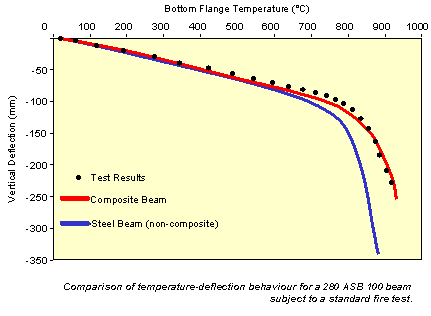
A standard fire test was conducted at the Warrington Fire Research Centre in 1996 [4] on a simply supported composite 280ASB100 asymmetric beam with normal-weight Grade 30 concrete cast onto deep-deck profiled sheeting with an A142 mesh. The yield stress of the steel, measured by tensile tests on coupons, was 402N/mm². The Vulcan analysis used a composite beam model including the slab, and the measured material properties and temperature profiles. The comparisons of mid-span deflections are shown in the figure, and are in close agreement.
Full scale fire test on the Slimdek floor system
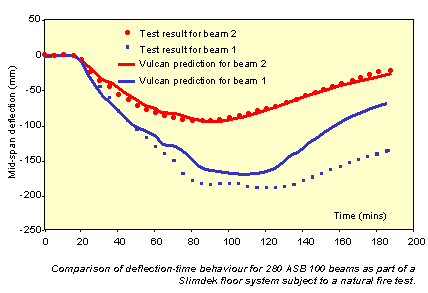
The Building Research Establishment (BRE) conducted a full-scale fire test on a composite Slimdek floor [5] extending across two bays of 6109mm in both directions. The slab was supported on a steel structure consisting of 254x254UC73 columns, 280ASB100 asymmetric beams and T-section (191x229x49) beams. The steel grade throughout was BSEN10025 S355 and C30concrete was used. The 295mm deep composite slab was cast on top of a SD225 deck. A single 20mm diameter reinforcing bar (Grade 460) was placed in each rib, and a uniformly distributed load of 6.88kN/m² was applied. The analytical results for the two beams are compared with the test results in the figure, and are in very good agreement.
- Gere, J.M. and Timoshenko, S.P., ‘Mechanics of Materials’, Third Edition, PWS-Kent Publishing Company, 1984.
- Yam, L. C. P. & Chapman, J. C., ‘The inelastic behaviour of simply supported composite beams of steel and concrete’, J. Inst. Civ. Engrs., 41(1) (1968) pp651-683.
- Wainman, D.E. and Kirby, B.R., ‘Compendium of UK Standard Fire Test Data Unprotected Structural Steel-1’, British Steel Corporation, Ref. No. RS/RSC/S10328/1/87/B, Swinden Laboratories, Rotherham.
- Wainman, D.E. and Martin, D.M., ‘Preliminary Assessment of the Data Arising from a Standard Fire Resistance Test Performed on a Slimflor beam at the Warrington Fire research Centre on 14th February, 1996’, Technical Note SL/HED/TN/S2440/4/96/D, British Steel Swinden Technology Centre, March 1996.
- Lennon, T., ‘Full Scale Fire Test on a Slimdek Floor System,’ BRE Client Report TCR 30/99, November 1998.
